Miele G4930BRWS, G4920BRWS, G4920SCBRWS, G4920SCCLST, G4920ICLST User Manual
...
Operating instructions for dishwashers
To avoid the risk of accidents or damage to the appliance, it is essential to read these instructions as well as the installation plan before it is in stalled and used for the first time.
en-AU, NZ |
HG05 |
M.-Nr. 10 075 760 |

2

|
Contents |
Guide to the appliance........................................................................................... |
6 |
Appliance overview.................................................................................................. |
6 |
Control panel............................................................................................................ |
7 |
Warning and Safety instructions .......................................................................... |
8 |
Caring for the environment ................................................................................. |
17 |
Disposal of the packing material............................................................................ |
17 |
Disposing of your old appliance ............................................................................ |
17 |
Energy-saving dishwashing ................................................................................... |
18 |
Before using for the first time............................................................................. |
19 |
Opening the door................................................................................................... |
19 |
Closing the door .................................................................................................... |
19 |
Safety lock ............................................................................................................. |
19 |
Water softener........................................................................................................ |
20 |
Displaying and setting the water hardness level .............................................. |
21 |
Before using the appliance for the first time, you require:..................................... |
23 |
Dishwasher salt...................................................................................................... |
23 |
Filling the salt reservoir ..................................................................................... |
24 |
Add salt reminder.............................................................................................. |
25 |
Rinse aid ................................................................................................................ |
26 |
Adding rinse aid ................................................................................................ |
26 |
Add rinse aid reminder...................................................................................... |
27 |
Setting the rinse aid dosage ............................................................................. |
28 |
Loading the dishwasher ...................................................................................... |
29 |
Notes...................................................................................................................... |
29 |
Upper basket ......................................................................................................... |
31 |
Adjusting the upper basket............................................................................... |
32 |
Lower basket ......................................................................................................... |
33 |
Cutlery.................................................................................................................... |
34 |
Cutlery tray........................................................................................................ |
34 |
Cutlery basket (depending on model)............................................................... |
35 |
Loading examples.................................................................................................. |
36 |
Dishwashers with cutlery tray ........................................................................... |
36 |
Dishwashers with cutlery basket ...................................................................... |
38 |
Comparison tests................................................................................................. |
40 |
Standard height with cutlery tray ........................................................................... |
40 |
XXL height with cutlery tray ................................................................................... |
43 |
Standard and XXL height with cutlery basket........................................................ |
46 |
3

Contents |
|
Operation .............................................................................................................. |
49 |
Detergent ............................................................................................................... |
49 |
Adding detergent .............................................................................................. |
51 |
Switching on the dishwasher................................................................................. |
52 |
Selecting a programme.......................................................................................... |
52 |
Starting the programme......................................................................................... |
53 |
Display ................................................................................................................... |
53 |
Energy management.............................................................................................. |
54 |
Programme finished ............................................................................................... |
54 |
Switching off .......................................................................................................... |
55 |
Unloading the dishwasher ..................................................................................... |
55 |
Interrupting a programme ...................................................................................... |
56 |
Changing a programme ......................................................................................... |
56 |
Programme options ............................................................................................. |
57 |
Short ................................................................................................................ |
57 |
DetergentAgent...................................................................................................... |
57 |
Switching off the refill indicators............................................................................ |
58 |
Delay start.............................................................................................................. |
59 |
Adjust Sensor wash ............................................................................................... |
61 |
Optimise standby................................................................................................... |
62 |
Factory default settings.......................................................................................... |
63 |
Programme chart ................................................................................................. |
64 |
Cleaning and care ................................................................................................ |
68 |
Cleaning the wash cabinet..................................................................................... |
68 |
Cleaning the door and the door seal ..................................................................... |
68 |
Cleaning the door front .......................................................................................... |
69 |
Checking the filters in the wash cabinet ................................................................ |
70 |
Cleaning the filters ................................................................................................. |
70 |
Cleaning the spray arms ........................................................................................ |
72 |
Problem solving guide ......................................................................................... |
73 |
Technical problems ................................................................................................ |
73 |
Water inlet fault ...................................................................................................... |
75 |
Water drainage fault............................................................................................... |
75 |
General problems................................................................................................... |
76 |
Noises .................................................................................................................... |
77 |
Unsatisfactory washing result................................................................................ |
78 |
Maintenance......................................................................................................... |
81 |
Cleaning the water inlet filter ................................................................................. |
81 |
Cleaning the drain pump and non-return valve ..................................................... |
82 |
4

|
Contents |
After sales service ............................................................................................... |
83 |
Repairs................................................................................................................... |
83 |
Warranty................................................................................................................. |
83 |
Optional accessories........................................................................................... |
84 |
Electrical connection........................................................................................... |
86 |
Water connection................................................................................................. |
87 |
The Miele Waterproof system ................................................................................ |
87 |
Connection to the water supply............................................................................. |
87 |
Drainage................................................................................................................. |
88 |
Technical data ...................................................................................................... |
89 |
5
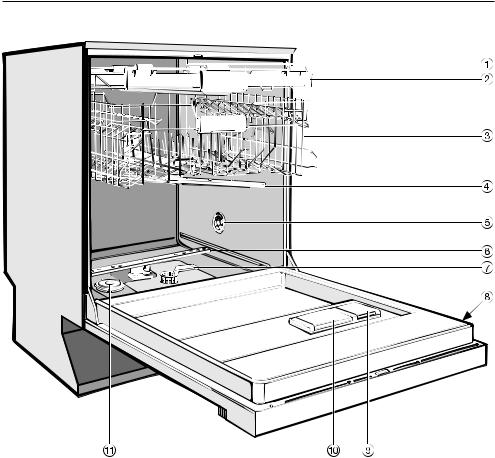
Guide to the appliance
Appliance overview
a Upper spray arm (not visible)
b Cutlery tray (depending on model) c Upper basket
d Middle spray arm
eAir inlet for drying (depending on model)
f Lower spray arm
g Filter combination h Data plate
i Rinse aid reservoir
jDual compartment detergent dis penser
k Salt reservoir
6
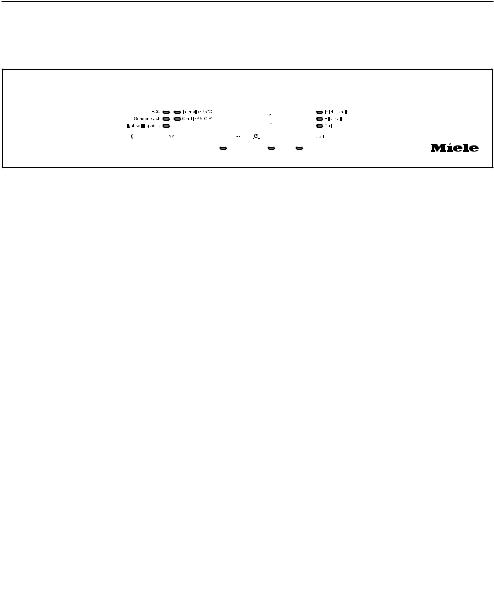
Guide to the appliance
Control panel
a Programme selection b Display
c Check/Refill indicators
d Start button with indicator light
e Short button with indicator light
fDelay start button with indicator light
g Programme selector button h On/Off button
These operating instructions apply to several different dishwasher models with different heights.
The specific dishwasher models are referred to as follows: Standard = 80.5 cm high dishwashers (integrated)
and 84.5 cm high dishwashers (freestanding) XXL = 84.5 cm high dishwashers (integrated)
7

Warning and Safety instructions
This dishwasher complies with current safety requirements. Inap propriate use can, however, lead to personal injury and damage to property.
To avoid the risk of accidents and damage to the dishwasher, please read the installation plan and the operating instructions carefully before it is installed and used for the first time. They con tain important information on its installation, safety, use and main tenance.
Keep the installation plan and the operating instructions in a safe place and pass them on to any future owner.
Miele cannot be held liable for damage caused by non-compli ance with this information.
8

Warning and Safety instructions
Correct application
This appliance is designed for domestic use and for use in similar environments by guests in hotel or motel rooms, bed & breakfasts and other typical living quarters. This does not include common/ shared facilities or commercial facilities within hotels, motels or bed & breakfasts.
This dishwasher is not suitable for outdoor use.
It must only be used as specified in these operating instructions for cleaning domestic crockery and cutlery. Any other usage is not supported by the manufacturer and could be dangerous.
This appliance is not intended for use by persons (including chil dren) with reduced physical, sensory or mental capabilities, or lack of experience and knowledge, unless they have been given supervi sion or instruction concerning its use by a person responsible for their safety, and are able to recognise the dangers of misuse.
9

Warning and Safety instructions
Safety with children
Young children must not be allowed to use this appliance.
Older children may only use the appliance when its operation has been clearly explained to them and they are able to use it safely, rec ognising the dangers of misuse.
Cleaning work may only be carried out by older children under the supervision of an adult.
Children should be supervised to ensure that they do not play with the appliance. Keep small children away from the appliance at all times to avoid the risk of injury. There is the risk that children may lock themselves in the dishwasher.
If the automatic door opening mechanism (depending on model) is active, keep young children away from the area in which the door opens. Danger of injury in the unlikely event of a fault with the open ing mechanism.
Danger of suffocation! Children may be able to wrap themselves in packing material or pull it over their heads with the risk of suffoca tion. Keep children away from any packing material.
Keep detergent and other household agents out of the reach of children at all times. Some dishwasher detergents are strongly alka line and contain irritants and corrosive ingredients. They can be ex tremely dangerous if swallowed, and can cause burning in the mouth, nose and throat, or inhibit breathing. Avoid contact with the skin and eyes. Keep children away from the dishwasher when the door is open. There could still be detergent residues in the cabinet or dispenser. Seek medical advice immediately if your child has swallowed or inhaled detergent, e.g. Poisons Information Centre (Australia) or National Poisons Centre (NZ).
10

Warning and Safety instructions
Technical safety
Repairs and other work by unqualified persons could be danger ous. Installation, maintenance work and repairs to electrical applian ces must only be carried out by a Miele approved service technician.
Before installation, check the dishwasher for visible signs of dam age. Under no circumstances should you use a damaged dishwash er. A damaged dishwasher could be dangerous.
The electrical safety of this appliance can only be guaranteed when continuity is complete between it and an effective earthing system. It is most important that this basic safety requirement is present and regularly tested and, where there is any doubt, the elec trical system in the house should be checked by a qualified electri cian.
Miele cannot be held liable for the consequences of an inadequate earthing system (e.g. electric shock).
Reliable and safe operation of this dishwasher can only be assur ed if it has been connected to the mains electricity supply.
The dishwasher must only be plugged into the electricity supply via a suitable switched socket. The electrical socket must be easily accessible after the dishwasher is installed so that it can be discon nected from the electricity supply at any time.
There must be no electrical sockets behind the dishwasher. Dan ger of overheating and fire risk if the dishwasher were to be pushed up against a plug.
The dishwasher must not be installed under a cooktop. The high radiant temperatures which are sometimes generated by a cooktop could damage the dishwasher. For the same reason, it should not be installed next to open fires or other appliances which give off heat, such as heaters etc.
11

Warning and Safety instructions
To avoid the risk of damage to the dishwasher, make sure that the connection data on the data plate (fuse rating, voltage and frequen cy) matches the mains electricity supply before connecting the dish washer to the mains. Consult a qualified electrician if in any doubt.
Do not connect the dishwasher to the mains supply until it has been fully installed and any adjustment has been made to the door springs.
The dishwasher may only be operated if the door opening mecha nism is working correctly. Otherwise there could be a risk of injury whilst the automatic door opening mechanism (depending on model) is active.
To check that the door opening mechanism is working correctly:
–the door springs must be adjusted equally on both sides. They are correctly adjusted when the door remains stationary when left half open (approx. 45° opening angle). It is also important that the door cannot fall open.
–the door locking pins automatically retract when the door opens at the end of the drying phase.
Do not connect the appliance to the mains electricity supply by a multi-socket adapter or an extension lead. These do not guarantee the required safety of the appliance (e.g. danger of overheating).
This appliance must not be installed and operated in mobile in stallations (e.g. on a ship).
Do not install the dishwasher in a room where there is a risk of frost. Frozen hoses may burst or split. The reliability of the electronic control unit may be impaired at temperatures below freezing point.
To avoid any damage to the appliance, the dishwasher must only be operated when it is connected to a fully vented plumbing system.
The plastic housing of the water connection contains an electrical valve. The housing must not be dipped in water.
12

Warning and Safety instructions
There are electrical wires in the water inlet hose. Do not cut the water inlet hose, even if it is too long.
The integrated Waterproof system offers protection from water damage, provided the following conditions are met:
–The dishwasher is correctly installed and plumbed in.
–The dishwasher is properly maintained and parts are replaced where it can be seen that this is necessary.
–The tap has been turned off when the appliance is not used for a longer period of time (e.g. during holidays).
The Waterproof system will work even if the appliance is switched off. However, the appliance must remain connected to the electricity supply.
The water pressure (flow pressure at the connection point) must be between 30 and 1000 kPa (0.3 and 10 bar).
A damaged appliance could be dangerous. If the dishwasher gets damaged, switch it off at the mains and call Miele.
The manufacturer's warranty will be invalidated if the appliance is not repaired by a Miele approved service technician.
Faulty components must only be replaced by genuine Miele spare parts. The manufacturer can only guarantee the safety of the appli ance when Miele replacement parts are used.
During installation, maintenance and repair work, the appliance must be disconnected from the mains electricity supply.
If the connection cable is damaged, it must be replaced with a special cable of the same type (available from Miele) by a Miele au thorised service technician only in order to avoid a hazard.
13

Warning and Safety instructions
In areas which may be subject to infestation by cockroaches or other vermin, pay particular attention to keeping the appliance and its surroundings in a clean condition at all times. Any damage which may be caused by cockroaches or other vermin will not be covered by the warranty.
Correct installation
The dishwasher must be installed and connected in compliance with the installation instructions.
Be careful when installing the dishwasher. Wear protective gloves to avoid injury on any sharp metal components.
The dishwasher must be correctly aligned to ensure problem-free operation.
In order to ensure stability, built-under and integrated dishwash ers must only be installed under a continuous worktop which is se cured to adjacent cabinetry.
If you want to convert your freestanding dishwasher to a built-un der ("U") model, you will need to order the appropriate conversion kit. If you remove the existing plinth, you must replace it with a U- model plinth. This is necessary to avoid the risk of injury caused by protruding metal parts.
The door springs on either side need to be evenly adjusted. They are correctly adjusted if the half-opened door (approx. 45° door opening angle) remains in this position when it is released. The door must not fall down under its own weight.
The appliance may only be used with correctly adjusted door springs.
14

Warning and Safety instructions
Correct use
Do not use solvents in the dishwasher. Danger of explosion!
Do not inhale or ingest dishwasher detergent. Some dishwasher detergents are strongly alkaline and contain irritants or corrosive in gredients. They can be extremely dangerous if swallowed, and can cause burning in the nose, mouth and throat, or inhibit breathing.
Avoid contact with the skin and eyes. Seek medical advice immedi ately if detergent has been swallowed or inhaled, e.g. Poisons Infor mation Centre (Australia) or National Poisons Centre (NZ).
Avoid leaving the door open unnecessarily as someone could trip over it and be injured by it.
Do not sit or lean on the opened door. This could cause the dish washer to tip and be damaged, and you could get injured.
Dishes can be very hot at the end of a programme. Allow them to cool until they are comfortable enough to handle before unloading.
Only use detergent and rinse aid formulated for domestic dish washers. Do not use washing-up liquid.
Do not use commercial or industrial detergents as these may cause damage, and there is a risk of a severe explosive chemical re action (such as an explosive oxyhydrogen gas reaction).
Do not fill the rinse aid reservoir with powder or liquid detergent. This will cause serious damage to the reservoir.
Inadvertently filling the salt reservoir with powder or liquid dish washer detergent will damage the water softener. Make sure you have picked up the correct packet of dishwasher salt before filling the salt reservoir!
Only use special coarse grained dishwasher salt for reactivation. Do not use other salts such as cooking salt, agricultural grade or gritting salt. These may contain insoluble additives which can impair the functioning of the water softener.
15

Warning and Safety instructions
In an appliance with a cutlery basket (depending on model) cut lery is cleaned and dried more efficiently if placed in the basket with the handles downwards. However, to avoid the risk of injury, place knives and forks etc. with the handles upwards.
Plastic items which cannot withstand being washed in hot water, such as disposable plastic containers, or plastic cutlery and crock ery should not be cleaned in the dishwasher. The high temperatures in the dishwasher may cause them to melt or lose shape.
If you use the "FlexiTimer/Delay start" option (depending on mod el), make sure that the dispenser is dry before adding detergent. Wipe dry if necessary. Detergent will clog if poured into a damp dis penser and may not be thoroughly dispersed.
Please observe the information given in "Technical data" regard ing the capacity of the dishwasher.
Accessories
Use only genuine original Miele spare parts. If spare parts or ac cessories from other manufacturers are used, the warranty will be in validated, and Miele cannot accept liability.
Disposal of your old dishwasher
Make the door lock inoperative so that children cannot acciden tally shut themselves in. Remove or destroy the locking bracket of the door lock, and make appropriate arrangements for the disposal of the appliance.
16
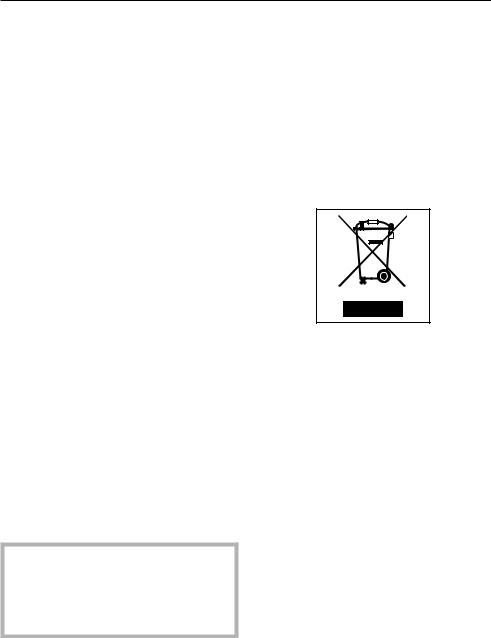
Caring for the environment
Disposal of the packing mate rial
The packaging is designed to protect the appliance from damage during transportation. The packaging materials used are selected from materials which are environmentally friendly for disposal and should be recycled.
The packaging consists of the following materials:
Outer packaging:
–Corrugated cardboard made from up to 100% recyclable material:
or: Polyethylene (PE) shrink wrap
–Polyproplylene (PP) strapping
Inner packaging:
–Chlorine and fluorine free expanded polystyrene (EPS)
–Base, lid frame and support battens made from untreated natural wood from renewable forests
–Polyethylene (PE) protective wrap
Recycling the packaging reduces the use of raw materials in the manufactur ing process and also reduces the amount of waste in landfill sites. Rather than just throwing these materials away, please ensure they are recycled.
Ensure that any plastic wrap pings, bags, etc. are disposed of safely and kept out of the reach of babies and young children. Danger of suffocation.
Disposing of your old appli ance
Electrical and electronic appliances of ten contain materials which, if handled or disposed of incorrectly, could be po tentially hazardous to human health and to the environment. They are, however, essential for the correct functioning of your appliance. Therefore, please do not dispose of your old appliance with your household waste.
Please dispose of it at your local com munity waste collection / recycling cen tre.
Ensure that your old appliance presents no danger to children while being stor ed for disposal.
To enable sorting by type of plastic for recycling, all plastic parts of the appli ance are labelled with international standard symbols.
17

Caring for the environment
Energy-saving dishwashing
This dishwasher is exceptionally eco nomical in its use of water and electrici ty.
You can make the most of your appli ance by following these tips:
–For most economical dishwashing, make full use of the baskets without overloading the dishwasher.
–Choose the programme to suit the type of crockery being washed and the degree of soiling.
–Select the ECO programme for ener gy-saving dishwashing. This pro gramme is the most efficient in terms of its combined energy and water consumption at cleaning normally soiled crockery.
–Follow the detergent manufacturer's recommendations on detergent dos age.
–When using powder or liquid deter
gent you can use 1/3 less detergent if baskets are only half full.
–If your household water system is suitable, this dishwasher can be con nected to a hot water supply for fur ther economies. If the water is heated by solar panels, for example, this would be energy efficient.
However, if your water is heated by electricity, we would recommend connection to cold water.
You can find further tips on energysaving dishwashing in "Miele's guide to dishwashing".
18

Before using for the first time
Opening the door
To open the door, reach under the door grip and pull.
If the door is opened during operation, all functions are automatically interrup ted.
Water in the dishwasher may be hot. Danger of scalding!
Only open the door during operation if absolutely necessary and exercise extreme caution when doing so.
Closing the door
Push the baskets right in.
Then lift the door upwards and push until it clicks into position.
Danger of injury!
Do not put your hand inside the door as it is closing.
Safety lock
Use the safety lock to prevent children opening the dishwasher door.
To lock the door, push the slide un derneath the door grip to the right.
To unlock the door, push the slide to the left.
19

Before using for the first time
Water softener
In order to achieve good cleaning re sults, the dishwasher needs to operate with soft water. Hard water results in a build-up of calcium deposits on crock ery and in the dishwasher.
Mains water with a hardness level high er than 0.7 mmol/l (4 °d - German scale) needs to be softened. This takes place automatically in the integrated water softener. The water softener in the dishwasher is suitable for a water hardness level of up to 12.6 mmol/l (70 °d - German scale).
–The water softener requires dish washer salt.
Depending on the water hardness level (< 3.8 mmol/l, or 21 °d - Ger man scale), dishwasher salt is not re quired if combination tablets are be ing used (see "Operation - Deter gent").
–The dishwasher must be program med for the water hardness level in your area.
–Your local water authority will be able to advise you of the water hardness level in your area.
–Where the water hardness fluctuates, e.g. between 1.8 and 2.7 mmol/l (10 - 15 °d - German scale), always pro gramme the dishwasher to the higher value (2.7 mmol/l or 15 °d in this ex ample).
In the event of a fault, it will help the service technician if you know the hard ness of your local water supply.
Enter the water hardness below:
____________mmol/l
The dishwasher is programmed at the factory for a water hardness level of 0.2 mmol/l (1 °d - German scale).
If this setting corresponds to the hard ness of your water, you do not need to do anything more.
However, if you have a different water hardness, you must adjust the water softener to match your water hardness.
20

Before using for the first time
Displaying and setting the water hardness level
Switch the dishwasher off with the button if it is switched on.
Press the Start button in and, whilst holding it in, switch the dishwasher on using the button.
Keep the Start button pressed in for at least four seconds until the Start indicator light comes on.
If this does not happen, start the proce dure from the beginning again.
Press the Delay start button twice.
The indicator light will flash rapidly twice at intervals.
The value which has been set for the water hardness is shown as a figure af ter in the display (see chart).
will start flashing in the display. This is the factory default setting of 0.2 mmol/l (1 °d - German scale).
Use the Start button to select the val ue which equates to your water hard ness level.
Each press of the button moves you up a level. When the highest water hardness level is reached, the setting starts from the beginning again.
The setting is now stored in memory.
Switch the dishwasher off with the button.
21

Before using for the first time
°d |
mmol/l |
°f |
Display |
1 |
0.2 |
2 |
1 |
|
|
|
|
2 |
0.4 |
4 |
2 |
|
|
|
|
3 |
0.5 |
5 |
3 |
|
|
|
|
4 |
0.7 |
7 |
4 |
|
|
|
|
5 |
0.9 |
9 |
5 |
|
|
|
|
6 |
1.1 |
11 |
6 |
|
|
|
|
7 |
1.3 |
13 |
7 |
|
|
|
|
8 |
1.4 |
14 |
8 |
|
|
|
|
9 |
1.6 |
16 |
9 |
|
|
|
|
10 |
1.8 |
18 |
10 |
|
|
|
|
11 |
2.0 |
20 |
11 |
|
|
|
|
12 |
2.2 |
22 |
12 |
|
|
|
|
13 |
2.3 |
23 |
13 |
|
|
|
|
14 |
2.5 |
25 |
14 |
|
|
|
|
15 |
2.7 |
27 |
15 |
|
|
|
|
16 |
2.9 |
29 |
16 |
|
|
|
|
17 |
3.1 |
31 |
17 |
|
|
|
|
18 |
3.2 |
32 |
18 |
|
|
|
|
19 |
3.4 |
34 |
19 |
|
|
|
|
20 |
3.6 |
36 |
20 |
|
|
|
|
°d |
mmol/l |
°f |
Display |
21 |
3.8 |
38 |
21 |
|
|
|
|
22 |
4.0 |
40 |
22 |
|
|
|
|
23 |
4.1 |
41 |
23 |
|
|
|
|
24 |
4.3 |
43 |
24 |
|
|
|
|
25 |
4.5 |
45 |
25 |
|
|
|
|
26 |
4.7 |
47 |
26 |
|
|
|
|
27 |
4.9 |
49 |
27 |
|
|
|
|
28 |
5.0 |
50 |
28 |
|
|
|
|
29 |
5.2 |
52 |
29 |
|
|
|
|
30 |
5.4 |
54 |
30 |
|
|
|
|
31 |
5.6 |
56 |
31 |
|
|
|
|
32 |
5.8 |
58 |
32 |
|
|
|
|
33 |
5.9 |
59 |
33 |
|
|
|
|
34 |
6.1 |
61 |
34 |
|
|
|
|
35 |
6.3 |
63 |
35 |
|
|
|
|
36 |
6.5 |
65 |
36 |
|
|
|
|
37-45 |
6.6-8.0 |
66-80 |
45 |
|
|
|
|
46-60 |
8.2-10.7 |
82-107 |
60 |
|
|
|
|
61-70 |
10.9-12.5 |
109-125 |
70 |
|
|
|
|
22

Before using for the first time
Before using the appliance for the first time, you require:
–approx. 2 litres of water,
–approx. 2 kg dishwasher salt,
–domestic dishwasher detergent,
–rinse aid formulated for domestic dishwashers.
Every dishwasher is tested at the fac tory. There will be residual water in the appliance from this test. It is not an in dication that it has been used previ ously.
Dishwasher salt
In order to achieve good cleaning re sults, the dishwasher needs to operate with soft water. Hard water results in a build-up of calcium deposits on crock ery and in the dishwasher.
Mains water with a hardness level high er than 0.7 mmol/l (4 °d - German scale) needs to be softened. This takes place automatically in the integrated water softener. The water softener in the dishwasher is suitable for a water hardness level of up to 12.6 mmol/l
(70 °d - German scale).
The water softener requires dishwasher salt.
Depending on the water hardness level (< 3.8 mmol/l, or 21 °d - German scale), dishwasher salt is not required if combi nation tablets are being used (see "Op eration - Detergent").
If the water hardness in your area is constantly lower than 0.9 mmol/l (5 °d), you do not need to add dish washer salt. The prompt to add dish washer salt will be switched off auto matically. The water softener must, however, still be programmed to cor
respond to the water hardness level in your area.
Dishwasher detergent will dam age the water softener.
Do not fill the salt reservoir with powder or liquid detergent.
Only use special coarse grained dishwasher salt for reactivation,
as other salts (e.g. cooking salt, agri cultural grade or gritting salt) may contain insoluble additives which can impair the functioning of the wa ter softener.
23

Before using for the first time
Filling the salt reservoir
Before filling the salt reservoir with dishwasher salt for the first time, you must fill it with approx. 2 litres of wa ter to enable the salt to dissolve.
Once the dishwasher has been used, there is always sufficient water in the reservoir.
Remove the lower basket and un screw the salt reservoir cap.
Water or saline solution will run out of the reservoir when the cap is re moved.
It should therefore only be removed in order to refill the salt reservoir.
Fill the reservoir with approx. 2 litres of water (first use only).
Place the funnel provided over the salt reservoir and carefully fill with dishwasher salt until the reservoir is full. The salt reservoir holds approx. 2 kg of salt depending on the brand used.
Clean any excess salt from around the reservoir opening and then screw the cap on again firmly.
Immediately after filling the salt reser voir, run the Gentle 45°C pro gramme with the Short pro gramme option selected and without any crockery in the dishwasher to re move any traces of salt from the cab inet.
24

Before using for the first time
Add salt reminder
Fill the salt reservoir with dishwasher salt when the Salt indicator light comes on (If it comes on during a programme, wait until the end of the programme).
Risk of corrosion!
Immediately after filling the salt res ervoir, run the Gentle 45°C pro gramme with the Short pro gramme option selected and without any crockery in the dishwasher to re move any traces of salt from the cabinet.
After the salt reservoir has been filled, the refill indicator may still be lit up if the salt concentration has not yet reached the correct level. It will go out when the correct concentration is reached.
The refill reminder will be switched off if you have programmed the dishwasher for a water hardness below 0.9 mmol/l (5 °d - German scale).
If you only ever use multi-function combination products in your dish washer, you can switch off both refill reminders for salt and rinse aid if you wish (see "Programme options - Switching off the refill indicators").
If you switch to using detergent that does not contain salt or rinse aid, it is important to remember to add dishwasher salt and rinse aid and to switch the reminders back on.
25
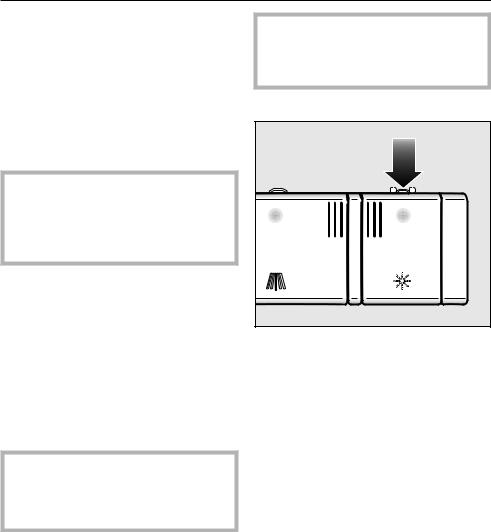
Before using for the first time
Rinse aid
Rinse aid is necessary to ensure water does not cling and leave marks on crockery during the drying phase and helps crockery dry faster after it has been washed.
Rinse aid is poured into the storage res ervoir and the amount set is dispensed automatically.
Inadvertently filling the rinse aid reservoir with powder or liquid deter gent will damage the reservoir. Only pour rinse aid formulated for domes tic dishwashers into the reservoir.
Alternatively, it is possible to use
–household vinegar with a max. 5% acid content
or
–liquid citric acid up to 10% acid con tent
The resulting rinsing and drying quality will not, however, be as good as when rinse aid is used.
Do not use vinegar with a higher acid content (e.g. vinegar essence 25% acid).
This would damage the dishwasher.
If you only ever use combination products containing rinse aid in your dishwasher, you do not need to add rinse aid.
Adding rinse aid
Press the button on the lid of the rinse aid reservoir in the direction of the arrow until the flap springs open.
26
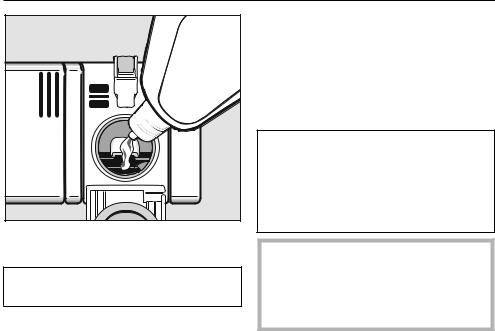
Before using for the first time
Add rinse aid only until it is visible in the opening.
The rinse aid reservoir holds approx.
110ml.
Close the flap firmly so that it clicks into place. Otherwise water can enter the rinse aid reservoir during a pro gramme.
Wipe up any spilled rinse aid. This prevents over-foaming occurring dur ing the next programme.
Add rinse aid reminder
When the Rinse aid indicator light comes on, the reservoir contains suffi cient rinse aid for 2 - 3 programmes on ly.
Add rinse aid in plenty of time.
If you only ever use multi-function combination products in your dish washer, you can switch off both refill reminders for salt and rinse aid if you wish (see "Programme options - Switching off the refill indicators").
If you switch to using detergent that does not contain salt or rinse aid, it is important to remember to add dishwasher salt and rinse aid and to switch the reminders back on.
27

Before using for the first time
Setting the rinse aid dosage
You can adjust the rinse aid dosage for best results.
The rinse aid dosage is set in stages from 0 to 6. It is set to 3 at the factory. This is the recommended setting.
If the "Adjust Sensor wash" programme function (depending on model) has been activated, the amount of rinse aid dispensed in the Sensor wash pro gramme can be higher than that set.
If spots appear on crockery and glass ware:
Increase the rinse aid dosage.
If clouding or smearing appears on crockery and glassware:
Decrease the rinse aid dosage.
Switch the dishwasher off with the button, if it is switched on.
Press the Start button in and, whilst holding it in, switch the dishwasher on using the button.
Keep the Start button pressed in for at least 4 seconds until the Start indi cator light comes on.
If this does not happen, start the proce dure from the beginning again.
Press the button 3 times.
The indicator will flash rapidly 3 times at intervals.
The dosage set will appear in the dis play after .
The flashing sequence will appear in the display.
This indicates the factory default setting 3.
Use the Start button to select the set ting required.
Each press of the button moves you up a level. After reaching the highest value, the counter starts from the be ginning again.
The setting is now stored in memory.
Switch the dishwasher off with the button.
28
